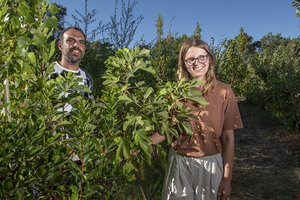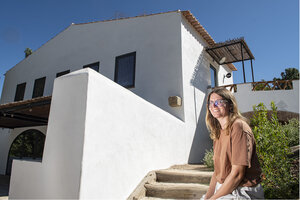How global innovators design a sustainable future

Martina Wiedemar and Joao Almeida pose for a photo at their agroforest in Gandum Village, Aug. 28, 2023, in Montemor-o-Novo, Portugal.
Alfredo Sosa/Staff
MONTEMOR-O-NOVO, Portugal; Maltahöhe, Namibia; and WALKERS RESERVE, Barbados
The sustainable village of the future, if Martina Wiedemar and Joao Almeida have any say about it, will have solar panels, earthen buildings, and an eco-friendly agroforest, a form of regenerative agriculture that mimics nature to produce climate-friendly food.
The field hands who work there will earn wages well above what’s standard for this rural area of Portugal. Those who take up residence here for a week, a month, or longer will be able to take classes on permaculture or local cooking, and to sample locally grown produce. Children will play together, exploring nature.
There will also be a turquoise swimming pool with a chic poolside restaurant and coworking space, designed in a white-washed Mediterranean style, with fast internet.
Why We Wrote This
Projects are sprouting up around the globe to build environmentally focused communities. These efforts aim to be practical and inviting, not idealistic.
“This place is an example that a sustainable life can be beautiful,” Mr. Almeida says of his family’s project, which they call Gandum Village. “It can be easy. It’s not just a hippie thing.”
Around the world, a growing number of ecological innovators such as Ms. Wiedemar and Mr. Almedia are reimagining landscapes, communities, and the way we live. In projects that range from “ecovillages” in sub-Saharan Africa to regenerative agriculture coworking spaces in Europe, to mines-turned-permaculture projects in Barbados, individuals and organizations are embarking on a hands-on rethinking of the future.
These efforts are part of a global increase in intentional ecological communities, according to experts. Ten years ago, for instance, there were around 440 ecovillages registered with the Global Ecovillage Network. Last year, there were 10,000.
But unlike past Utopian collectives, projects like Gandum Village are decidedly pragmatic. They’re not isolating themselves from the mainstream world; they want the public to come and stay a while – or at least buy their produce.
“Ultimately, we all have to be living in ecovillages, whether we call them that or not,” says Daniel Greenberg, co-director of the Foundation for Intentional Community and past president of the Global Ecovillage Network.
That’s not as radical as it might sound, he argues. These projects, Dr. Greenberg says, are “trying to create wholes that are more than the sum of their parts. They’re trying to create culture, stories about how we live locally and globally in harmony with each other and the planet.”
Ecovillage life in the desert
Buying local is one goal of a new project called RuralRevive – Building a Desert Based Economy, based in the village of Maltahöhe in central Namibia, in southern Africa.
The village sits on the road between the capital, Windhoek, and some of the most-visited parts of the Namib desert. A former karakul sheep center that’s fallen on hard times, it is also the center of an effort to reimagine a future for people, wildlife, and agriculture.
RuralRevive is just over 100 miles west of NamibRand, a private conservation effort where tourists stay in upscale, low-impact lodgings – and the project is evolving into a service center for a desert economy. Its laundry facility helps hotels wash sheets and towels (as opposed to the hotels doing the same where water is scarcer), and it has a new greenhouse to provide relatively local produce. At the same time, it trains locals such as Elrico Bekeur in horticulture and entrepreneurship.
In a bright greenhouse, surrounded by the parched landscape made worse by Namibia’s persistent drought, Mr. Bekeur nurtures his broccoli and Brussels sprouts with a drizzle of water.
“These are just babies,” he says, gently tending to his plants. “Just like a baby cannot go a day without breastfeeding, they cannot go a day without water.”
Mr. Bekeur, whose parents died when he was 8 years old, quit school in eighth grade and started work as a “yard boy” at a farm. “That’s when I really fell in love with living things,” he says. He was always trying to grow a garden outside his family’s shack in an informal settlement on the edge of Maltahöhe. His late grandfather used to scoff at his effort – until the COVID-19 pandemic rendered them without any food other than what Mr. Bekeur could grow.
Today that scrappy garden has grown to three times the size of his simple shack, rigged with a sleek irrigation system feeding a jungle of greenery with the savvy he has learned from RuralRevive about growing fruits and vegetables in the desert earth. “I’m hoping in my heart that my neighborhood will all start growing their own produce, their own food for themselves,” he says. “I’m very happy that something has happened in my hometown. Maltahöhe is not just a place where people will have a job, but where they will learn something.”
But the purpose of RuralRevive, where on a quiet Sunday locals who live there are stringing up laundry to dry in the fresh air, is not just economic. For those involved, it’s also an expression of a much deeper narrative about what future they face as the planet warms – and a recalibration of their notion of progress.
Reinhold Mangundu, RuralRevive’s project manager, is a young climate activist who has received international attention for his fight against Canadian oil company ReconAfrica in the Okovanggo Basin. He began this project with a longing for past communal life. He remembers sitting by a bonfire, listening to his father, a subsistence farmer, tell him about the forest and birds of his birthplace in the north of his country. Those village fires lit a desire in him to restore and regenerate the earth and wildlife that he could only imagine.
“I believe it’s time we start building beautiful stories about the future and use those stories ... of the future to address our current problems,” he says.
Transforming a sand mine in Barbados
Across an ocean, in the Scotland District of the eastern Caribbean island of Barbados – named, in part, for its green slopes plunging into the ocean – a project to repurpose one of the region’s largest sand mines is also seeking to design a new future.
Walkers Quarry once supplied the silica sand used in nearly all of Barbados’ construction projects. But these days the bulldozers are being replaced by the pickup trucks of horticulturalists, scientists, and volunteers who are exploring how to transform an extractive landscape into a model of future resilience in a warming world. They now call it Walkers Reserve. They are planting cuscus grass to help stabilize slopes, tending to mangroves that naturally clean riverways, and testing crops that not only might fare well in the wind-swept, warming coast of this island, but also could help capture carbon as a climate solution.
Those involved in the project say the lessons learned here could help others across the island with everything from food security to reforestation.
“We are showing how nature-based solutions can be put into place, and how that can be scaled,” says Elize Rostant, managing director of Walkers Institute for Regenerative Research, Education and Design, the nonprofit founded to oversee the transition from extractive mine to regenerative solution.
Discovering new models
But for many future-based eco projects, scale isn’t as important as finding a new model of living – one that is less about getting “bigger and better” and more about new understandings about what progress, and sustainability, can mean.
Some criticize these efforts as being so small that they barely make a difference – and say that isolated examples don’t do much to either shift wider patterns of consumption or counter the economic realities in which most people live.
But those participating in building these projects say they’re simply taking the first steps for a better world.
Five years ago, Ms. Wiedemar and Mr. Almeida purchased this abandoned 98-acre farm in the Alentejo region of central Portugal, a land of cork trees and cattle farms and increasing drought. They wanted to put into practice the book learning they had gathered in Ms. Wiedemar’s native Switzerland, through studies and careers focused on climate change and food sustainability.
So with their three young children in tow, the couple had returned to Mr. Almeida’s home country and began to imagine Gandum Village – a place that would be a model not only of regenerative agriculture but also of a different, more sustainable way to live: one that was more collective, less focused on economic growth, more in tune with the earth, and exquisitely designed.
When the couple realized that small-scale agriculture would not be financially viable, they decided to open a set of short-term stay apartments and a hotel, along with a coworking center and an approach to child care that could allow people to work, eat, and live together. They are working with local farmers on their agroforestry project, and already see improved drought-resistance in some crops. They plan to hold events, from weddings to conferences, and work closely with a collective of professionals who have agreed to eschew economic growth in favor of community, creativity, and collaboration.
“When they hear ‘sustainable,’ people think about the negatives, the ‘less,’” Ms. Wiedemar says. “We want to show them the ways for it to be positive.”


